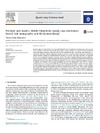Identificador persistente para citar o vincular este elemento:
https://accedacris.ulpgc.es/jspui/handle/10553/74734
| Campo DC | Valor | idioma |
|---|---|---|
| dc.contributor.author | Vidal Matutano, Paloma | en_US |
| dc.date.accessioned | 2020-10-14T11:43:25Z | - |
| dc.date.available | 2020-10-14T11:43:25Z | - |
| dc.date.issued | 2017 | en_US |
| dc.identifier.issn | 1040-6182 | en_US |
| dc.identifier.uri | https://accedacris.ulpgc.es/handle/10553/74734 | - |
| dc.description.abstract | Spatial analyses of Palaeolithic sites typically defined by hearth-related assemblages have been mostly based on lithic and faunal remains. By using spatial analysis methods in conjunction with analytical units with higher temporal resolution than typical stratigraphic units, synchronic and diachronic relationships between artifacts deposited during successive occupation events have been elucidated. Spatial analyses applied to archaeobotanical remains are scarce, and when available, are typically focused on carpological remains (seeds and fruits). The lack of spatial indicators among anthracological remains hampers obtaining significant data linked to the relationships established between the combustion features and scattered charcoal fragments recovered from excavated occupation surfaces. To address this problem, the charcoal assemblage from El Salt Stratigraphic Unit (SU) Xb (Archaeosedimentary Facies Association 2 [AFA 2]) is analyzed using spatial analysis methods. Results suggest that the integration of anthracological remains into a palimpsest dissection analyses is vital to better understand the relationship between combustion structures and activity areas. These results highlight the utility of spatial and statistical methods as important tools for future anthracological analyses to provide meaningful information related to taxa distribution and the last firewood used in combustion structures. | en_US |
| dc.language | eng | en_US |
| dc.relation.ispartof | Quaternary International | en_US |
| dc.source | Quaternary International [ISSN 1040-6182], v. 457 (1), p. 74-84 | en_US |
| dc.subject | 550405 Prehistoria | en_US |
| dc.subject | 241710 Paleobotánica | en_US |
| dc.subject.other | El Salt | en_US |
| dc.subject.other | Middle Palaeolithic | en_US |
| dc.subject.other | Charcoal analysis | en_US |
| dc.subject.other | Spatial analysis | en_US |
| dc.subject.other | Palimpsests | en_US |
| dc.subject.other | Combustion | en_US |
| dc.title | Firewood and hearths: Middle Palaeolithic woody taxa distribution from El Salt, stratigraphic unit Xb (Eastern Iberia) | en_US |
| dc.identifier.doi | 10.1016/j.quaint.2016.07.040 | en_US |
| dc.investigacion | Artes y Humanidades | en_US |
| dc.type2 | Artículo | en_US |
| dc.utils.revision | Sí | en_US |
| dc.identifier.ulpgc | Sí | en_US |
| item.grantfulltext | open | - |
| item.fulltext | Con texto completo | - |
| crisitem.author.dept | GIR Investigación en Arqueología y Patrimonio | - |
| crisitem.author.orcid | 0000-0002-5892-149X | - |
| crisitem.author.parentorg | Departamento de Ciencias Históricas | - |
| crisitem.author.fullName | Vidal Matutano,Paloma | - |
| Colección: | Artículos | |
Citas de WEB OF SCIENCETM
Citations
42
actualizado el 08-jun-2025
Visitas
65
actualizado el 11-feb-2023
Descargas
105
actualizado el 11-feb-2023
Google ScholarTM
Verifica
Altmetric
Comparte
Exporta metadatos
Los elementos en ULPGC accedaCRIS están protegidos por derechos de autor con todos los derechos reservados, a menos que se indique lo contrario.
